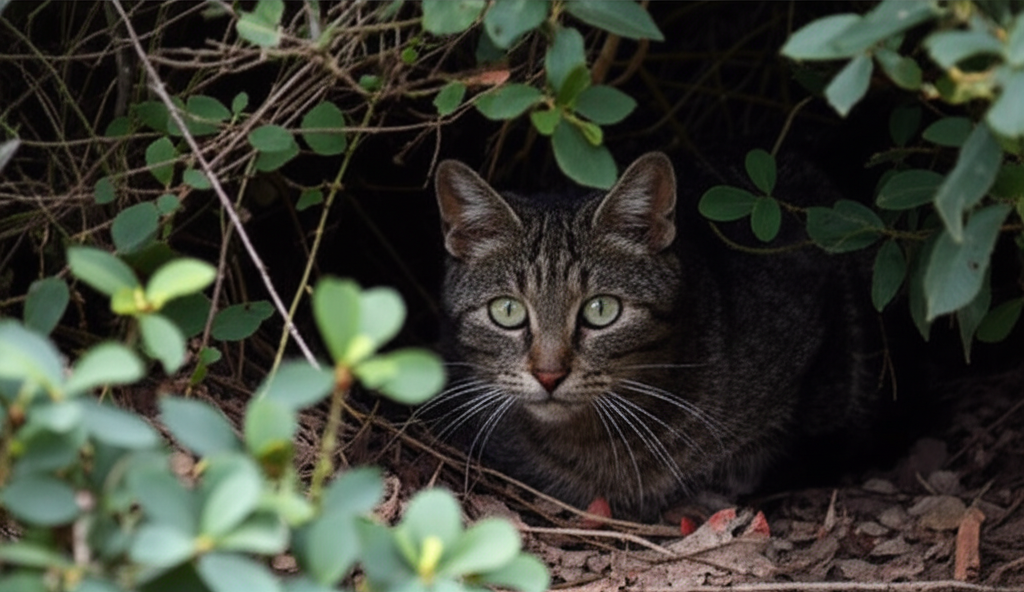
Understanding Feral vs. Stray Cats: What's the Difference?
Learn how to identify whether a cat is feral or stray, and how to approach each situation.
When encountering an outdoor cat, it's important to understand whether you're dealing with a feral cat or a stray. While they may look similar at first glance, these cats have very different backgrounds, behaviors, and needs. Knowing the difference can help you respond appropriately and provide the right kind of assistance.
In this article, we'll explore the key differences between feral and stray cats, how to identify each, and the best approaches for helping them. This knowledge is essential for anyone involved in cat rescue, TNR programs, or simply concerned about the outdoor cats in their neighborhood.
| Characteristic | Stray Cat | Feral Cat |
|---|---|---|
| Origin | Former pet that has been lost or abandoned | Born and raised in the wild with little or no human contact |
| Socialization | Socialized to humans; may approach people | Unsocialized to humans; avoids human contact |
| Body Language | Tail up, may make eye contact, might meow | Crouched body posture, avoids eye contact, rarely vocalizes |
| Activity Time | May be active during daytime | Primarily nocturnal, avoids daytime activity |
| Living Location | May seek shelter near humans | Lives in colonies away from human activity |
| Best Outcome | Often can be rehomed as a pet | Usually best served by TNR and outdoor management |
What Is a Stray Cat?
A stray cat is a domestic cat that once had a home but has been lost or abandoned. These cats have had socialization with humans during their critical developmental period (2-7 weeks of age) and are accustomed to human contact.
Stray cats often show signs of their domestic origins in their behavior. They may approach people, vocalize (meow), and display body language that indicates comfort around humans, such as a raised tail when greeting people or making eye contact.
However, the longer a cat lives as a stray, the more wary of humans it may become. A recently lost pet might be friendly and approachable, while a cat that has been on its own for months or years might display more cautious behavior that can sometimes be confused with that of a feral cat.
Key Indicators of a Stray Cat: Approaches humans (even if cautiously), makes eye contact, meows, visible during daylight hours, may appear lost or disoriented, might respond to food or treats.

Stray cats often show interest in human interaction
What Is a Feral Cat?
A feral cat is a cat that was born and raised in the wild or has lived away from humans for so long that it has reverted to a wild state. Feral cats have had little to no socialization with humans during their critical developmental period and therefore do not see humans as a source of food, shelter, or affection.
Feral cats typically live in colonies—groups of related cats that live together in a specific territory. These colonies form complex social structures and often develop around a food source. Feral cats are highly skilled at surviving outdoors and have developed behaviors that help them avoid danger, including humans.
It's important to understand that feral cats are not socialized to people and cannot be transformed into lap cats. Adult feral cats usually cannot be tamed and are not suitable for adoption. Attempting to socialize an adult feral cat can cause extreme stress for the animal.
Key Indicators of a Feral Cat: Avoids human contact, flees when approached, remains hidden during daylight hours, crouches low to ground when moving, does not meow (though may hiss or growl if cornered), lives in a colony with other cats.

Feral cats typically avoid human interaction
The Gray Area: Semi-Feral Cats
Not all cats fit neatly into the categories of "stray" or "feral." Some cats fall into a gray area often referred to as "semi-feral." These may be:
- Stray cats that have been on their own for so long they've become more wary of humans
- Feral cats that have had some positive interactions with humans
- Cats that were not properly socialized as kittens but had some human contact
- Offspring of a stray mother who had some exposure to humans
Semi-feral cats may show mixed behaviors—perhaps allowing some human proximity but not touch, or accepting food from humans but fleeing if approached too closely. With time, patience, and proper techniques, some semi-feral cats can become more comfortable with human presence and even develop into companion animals.
How to Help Stray Cats
If you've identified a cat as a stray, here are appropriate ways to help:
- Check for identification: Look for a collar, tag, or microchip (a vet can scan for this).
- Report to local authorities: Contact animal control, shelters, and rescue groups. The cat may be someone's lost pet.
- Provide food and temporary shelter: This can help keep the cat in the area while you determine next steps.
- Approach carefully: Use slow movements, soft voices, and food to build trust.
- Consider fostering: If no owner is found, you might temporarily house the cat while seeking a permanent home.
- Seek veterinary care: Have the cat examined, vaccinated, and spayed/neutered if needed.
- Find a permanent solution: This might be adoption, return to owner, or in some cases, a managed TNR program if the cat cannot be socialized enough for indoor living.
Success Story: "Max was a stray cat who kept appearing on my porch. After slowly gaining his trust with food, I was able to get close enough to see he had a collar that had become embedded in his fur. A vet visit revealed a microchip, and Max was reunited with his family who had been searching for him for months!" — Maria T., Cat Rescuer
How to Help Feral Cats
Feral cats require a different approach than strays:
- Trap-Neuter-Return (TNR): This is the most humane and effective approach for feral cats. They are trapped, spayed/neutered, vaccinated, ear-tipped (the universal sign of a sterilized community cat), and returned to their territory.
- Provide food and water: Establish a regular feeding schedule to help monitor the colony's health.
- Create outdoor shelters: Protect cats from extreme weather with simple shelters.
- Monitor health: Watch for signs of illness or injury that might require intervention.
- Manage the environment: Keep feeding areas clean and work with neighbors to address any concerns.
- Consider relocation only as a last resort: Feral cats are strongly bonded to their territory, and relocation is stressful and should only be done when absolutely necessary for their safety.
Important: Attempting to force a feral cat into a home environment is usually traumatic for the cat. Most adult feral cats are happiest living outdoors in their familiar territory with proper care from caretakers.
Special Case: Feral Kittens
Feral kittens represent a special opportunity. If found young enough (ideally before 8 weeks of age), they can often be socialized and adopted into homes. The process requires patience and proper techniques but can result in well-adjusted companion cats.
If you find feral kittens:
- Determine their age (this affects socialization potential)
- Look for the mother cat (kittens under 8 weeks still need their mother)
- Contact a rescue organization experienced with feral kitten socialization
- If you plan to socialize them yourself, research proper techniques
- Ensure all kittens receive proper veterinary care
Remember that the mother cat should be trapped, spayed, and returned to prevent future litters, even if the kittens are taken for socialization.
Key Takeaways
- Stray cats are former pets that have been lost or abandoned and are generally socialized to humans
- Feral cats are born in the wild with little to no human contact and are not socialized to people
- Semi-feral cats fall somewhere in between and may show mixed behaviors
- Stray cats can often be rehabilitated and adopted into homes
- Adult feral cats are usually best served by TNR programs and outdoor management
- Feral kittens under 8 weeks can often be socialized and adopted
- Understanding the difference helps provide appropriate care for each type of cat

Alex Chen
Feline Behaviorist
Alex Chen is a certified feline behaviorist with over a decade of experience working with community cats. They have helped socialize hundreds of feral kittens and have trained volunteers across the country in TNR techniques and feral cat management. Alex currently manages a successful TNR program in an urban area and consults with animal shelters on feral cat issues.
Related Articles
Want to learn more about cat behavior?
Subscribe to our newsletter for expert insights and educational resources.


